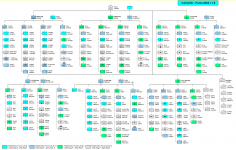FJAG
Army.ca Legend
- Reaction score
- 15,179
- Points
- 1,160
Your points are all very valid.
I diverge on the idea of having 3 x Mech and 3 x Light battalions at 100% strength for one reason and only one reason.
The way I see 70/30 battalions and 30/70 battalions being employed is by way of loosely twinned brigades - one brigade predominantly RegF the other predominantly ResF. In each brigade the battalions have either two companies (for the 70/30) or one company (for the 30/70) that are at 100% RegF strength. The remaining one and two companies are at 5% RegF / 95% ResF. The purpose of this is to be able to create a force of roughly twice the size of the three current RegF brigades and which are all fully under RegF leadership. In other words the structures purpose is to enable the ResF to rise up in capability by having RegF leadership and equipment available throughout all their training. Effectively one CO is responsible for collective training of his RegF personnel during Sept to April and of his ResF members during a weekend a month and two weeks in the summer. Depot battalions would be responsible for the bulk of individual training for both RegF and ResF. Having 6 battalions at 100% Reg F strength severely reduces that capability to the point of impossibility.
IMHO, we rarely deploy battalions at 100% strength anyway. The BG in Latvia has one company and CS and CSS. Essentially any 30/70 or 70/30 battalion could do the current eFP Latvia task with minor augmentation from its ResF elements. The same with our training mission in Ukraine.
In the rare eventuality where a 100% battalion-sized rapid force is required then a 70/30 battalion could deploy with its two 100% RegF companies and one additional 100% RegF company (with its equipment) from another battalion (like we frequently did for Afghanistan). In the same way, the battalion HQ and CS and CSS would be rounded out by predesignated RegF pers from another 70/30 or 30/70 battalion. Quite clearly a rapid reaction standby force would need predesignating so that a rapid assembly becomes possible.
With time, once the ResF components become viable, it would be easier to have a list of stand-by volunteer ResF members to round out or even be "activated" for a rapid deployment.
My suggestion is not the only one. Other ways of doing this are possible, but to truly bring about lasting change we need a system whereby ResF personnel receive the benefit of proper leadership and training within the framework of of a proper part-time system. In short we need to make them a properly trained and led part-time reserve, not merely a lesser semi-qualified alternate force.

I diverge on the idea of having 3 x Mech and 3 x Light battalions at 100% strength for one reason and only one reason.
The way I see 70/30 battalions and 30/70 battalions being employed is by way of loosely twinned brigades - one brigade predominantly RegF the other predominantly ResF. In each brigade the battalions have either two companies (for the 70/30) or one company (for the 30/70) that are at 100% RegF strength. The remaining one and two companies are at 5% RegF / 95% ResF. The purpose of this is to be able to create a force of roughly twice the size of the three current RegF brigades and which are all fully under RegF leadership. In other words the structures purpose is to enable the ResF to rise up in capability by having RegF leadership and equipment available throughout all their training. Effectively one CO is responsible for collective training of his RegF personnel during Sept to April and of his ResF members during a weekend a month and two weeks in the summer. Depot battalions would be responsible for the bulk of individual training for both RegF and ResF. Having 6 battalions at 100% Reg F strength severely reduces that capability to the point of impossibility.
IMHO, we rarely deploy battalions at 100% strength anyway. The BG in Latvia has one company and CS and CSS. Essentially any 30/70 or 70/30 battalion could do the current eFP Latvia task with minor augmentation from its ResF elements. The same with our training mission in Ukraine.
In the rare eventuality where a 100% battalion-sized rapid force is required then a 70/30 battalion could deploy with its two 100% RegF companies and one additional 100% RegF company (with its equipment) from another battalion (like we frequently did for Afghanistan). In the same way, the battalion HQ and CS and CSS would be rounded out by predesignated RegF pers from another 70/30 or 30/70 battalion. Quite clearly a rapid reaction standby force would need predesignating so that a rapid assembly becomes possible.
With time, once the ResF components become viable, it would be easier to have a list of stand-by volunteer ResF members to round out or even be "activated" for a rapid deployment.
My suggestion is not the only one. Other ways of doing this are possible, but to truly bring about lasting change we need a system whereby ResF personnel receive the benefit of proper leadership and training within the framework of of a proper part-time system. In short we need to make them a properly trained and led part-time reserve, not merely a lesser semi-qualified alternate force.






